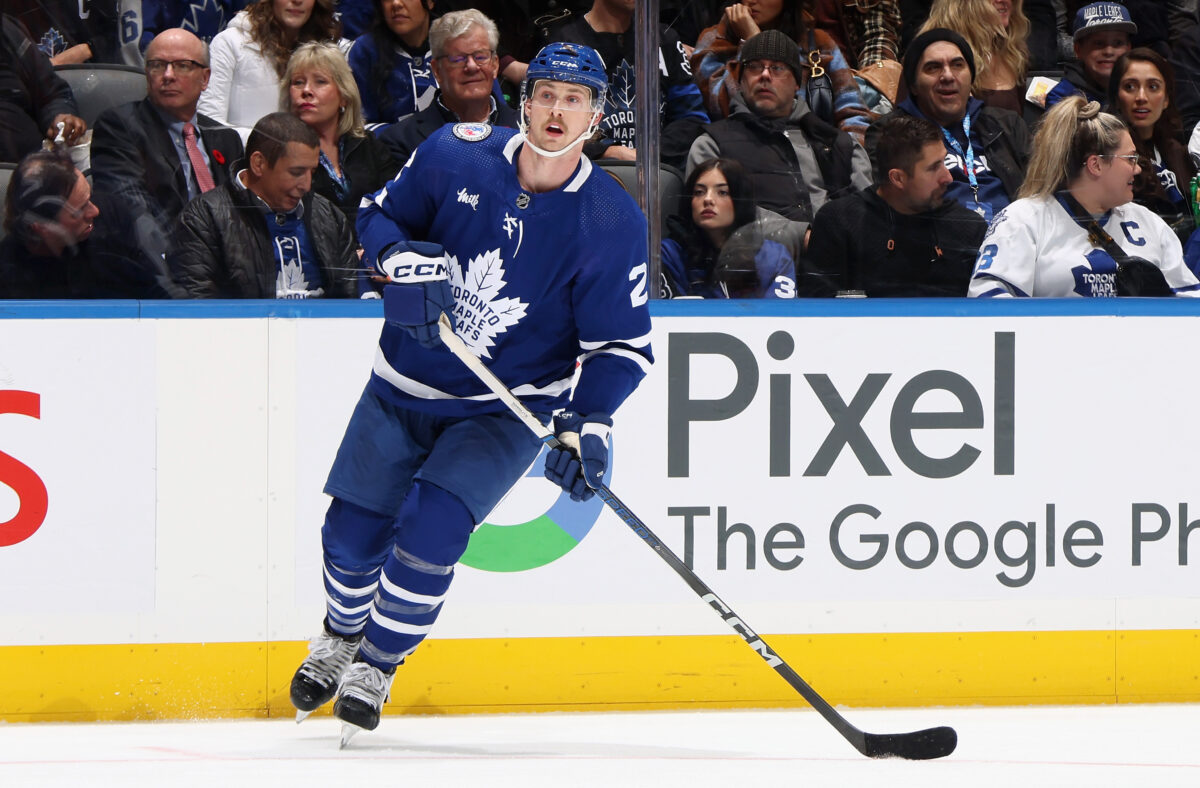Once the 2023-24 season ends, the Toronto Maple Leafs will have three expiring restricted free agents (RFAs) on defence who they will either have to extend to another contract or let go from the organization: Timothy Liljegren, Simon Benoit, and Maxime Lajoie. If we assume that none of them are traded by next season, which is likely, it’s important to gauge what their next contracts could look like, especially when considering that the Maple Leafs will be in a bit of a cap crunch in 2024-25 by proxy of Auston Matthews’ and William Nylander’s raises kicking in.
Being that Lajoie has only played four games this season, and has been a career AHLer, I will be excluding him from this list, as I assume he’s either going to be let go by the organization or signed to a two-way, league-minimum contract and have most of his playing time with the Toronto Marlies. I also have to assume that, given the career trajectories of both Liljegren and Benoit, neither will be offered a long-term deal. It’s likely in the best interest of both the Maple Leafs and players that they’re offered bridge contracts.
Timothy Liljegren
24-year-old Liljegren should be getting a raise from the two-year, $1.4 million average annual value (AAV) contract that he signed in June 2022, but it shouldn’t be all that significant a pay increase. For the most part, players around the NHL make their dough by putting up points, and Liljegren certainly isn’t known for that side of his game — his career-high in points is 23. He has taken on a bigger role this season, though, slotting in on the second pairing and second power-play unit. The former 17th overall pick in 2017 is having an outstanding two-way season, having the highest expected goals share (xGF%) among Maple Leafs’ defencemen with at least 25 games played with 54.4%, placing second in both expected goals for per 60 minutes (xGF/60) and expected goals against per 60 minutes (xGA/60) among that crew as well.

In predicting what players’ next contracts will look like, it’s important to scour the league for players with similar stats, playstyles, and even sizes who signed bridge deals around age 24. A few players that fit that profile are Oliver Kylington, Gustav Forsling, and Matt Roy. All three are extremely capable two-way defencemen, who at the time of signing their bridge deals, were 24, 25, and 26 years old, respectively. In addition to that, at that point in their careers, they’d capped out at 31, 17, and 18 points, right around where Liljegren’s career high sits at. Their underlying statistics are similar, with all four defencemen having career xGF%s of about 54% while playing in a second-pair role. Even their sizes are comparable — the foursome are all listed as either 6-foot-0 or 6-foot-1 and between 180-200 pounds.
Related: Maple Leafs: Reaves Defends Reilly’s Reaction to Ridly Greig
Kylington’s bridge deal came in at $2.5 million for two years, which was, at the time of the signing, 3.03% of the salary cap. Forsling’s three-year, $2.67 million contract took up 3.28% of the cap, and Roy’s three-year, $3.15 million contract was responsible for 3.87% of the cap. Considering that Liljegren will be looking to extend in a season where the salary cap is expected to be $87.7 million, I would anticipate that his contract takes up about 3.5% of the cap. My prediction then is that he is offered a three-year worth $3 million annually.
Simon Benoit
Benoit, who wants to re-sign this offseason, has been a shockingly good addition to the Maple Leafs’ blue line, despite whatever shortcomings he may have on the scoresheet. His xGF% on the season is 53.06%, and he’s been a very serviceable third-pair, defence-first blueliner. He’s a big body, isn’t afraid to toss his weight around, and is still just 25 years of age. Again, he isn’t going to put up many points — he’s got two on the season and a career-high of 10 — but that’s not his role.
Finding comparable players for Benoit is a bit more difficult — there aren’t a ton of huge, defence-first, third-pair defencemen who are both entering their primes and struggling to put up points. Still, some names come to mind: Ben Harpur, Jacob Larsson, and Justin Falk. All three are massive, defence-first guys who had a relatively weak statistical profile except for their contract years. Harpur’s career-high in points is seven, Larsson’s is 11, and Falk’s, who has not played in the NHL since 2018-19, was nine.

Harpur’s contract extension in his age-25 season was a two-year deal valued at $725,000 annually, taking up 0.97% of the 2018-19 cap. Larsson signed a two-year, $1.2 million AAV contract with the Anaheim Ducks at age 24, and that took up 1.47% of the salary cap. Finally, there’s Falk, whose one-year, $602,000 contract in 2011-12 took up 0.94% of the salary cap. Keeping these in mind, I would anticipate that Benoit will be offered a two-year deal worth $1 million per year, which would take up 1.14% of next season’s cap. I could also imagine a world in which general manager (GM) Brad Treliving and the Maple Leafs are more bullish on Benoit given his stellar play this season, and offer him a little bit more money, though I have a hard time thinking he’d get more than $1.25 million.
Maple Leafs Have Opportunity to Smartly Sign Two Cheap Defencemen
The Maple Leafs are about to enter their most challenging season in terms of the NHL salary cap, considering that four players on their roster will be taking up well over half of it. As such, it’s incredibly important to sign players like Liljegren and Benoit — role players who are still effective rather than solely relying on their grit — to as team-friendly a contract as possible. I doubt either would ask for something unreasonable. Still, it is incredibly important for the Maple Leafs’ immediate future for Treliving to win these negotiations, unlike what transpired with Matthews and Nylander.
